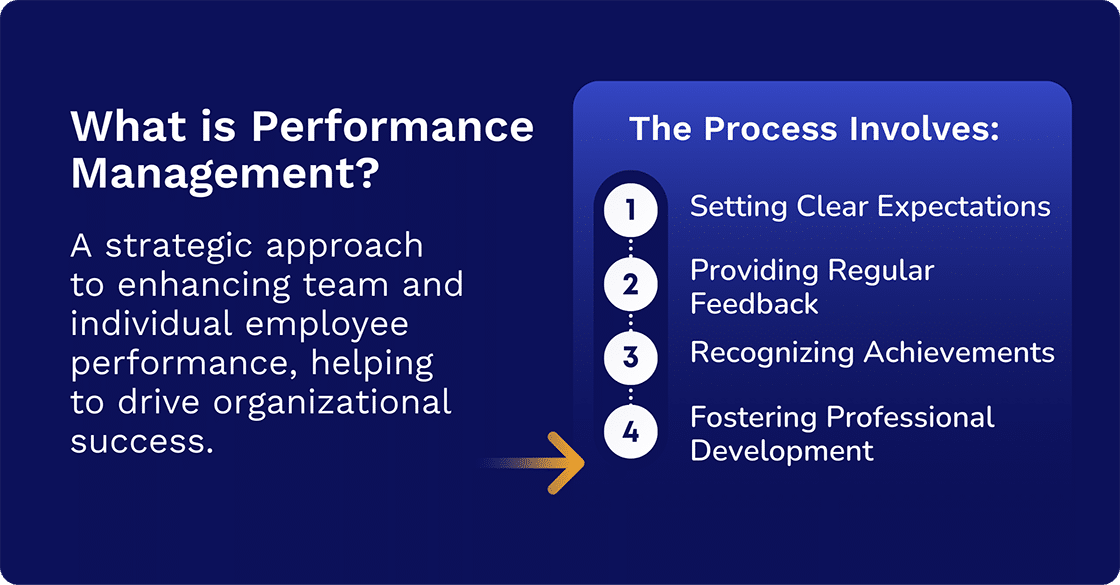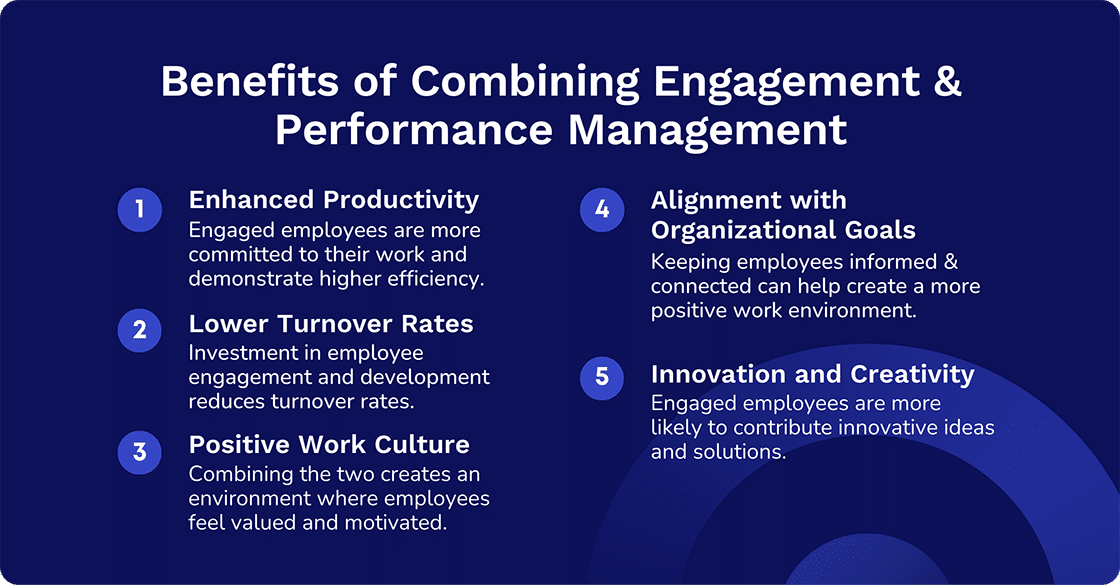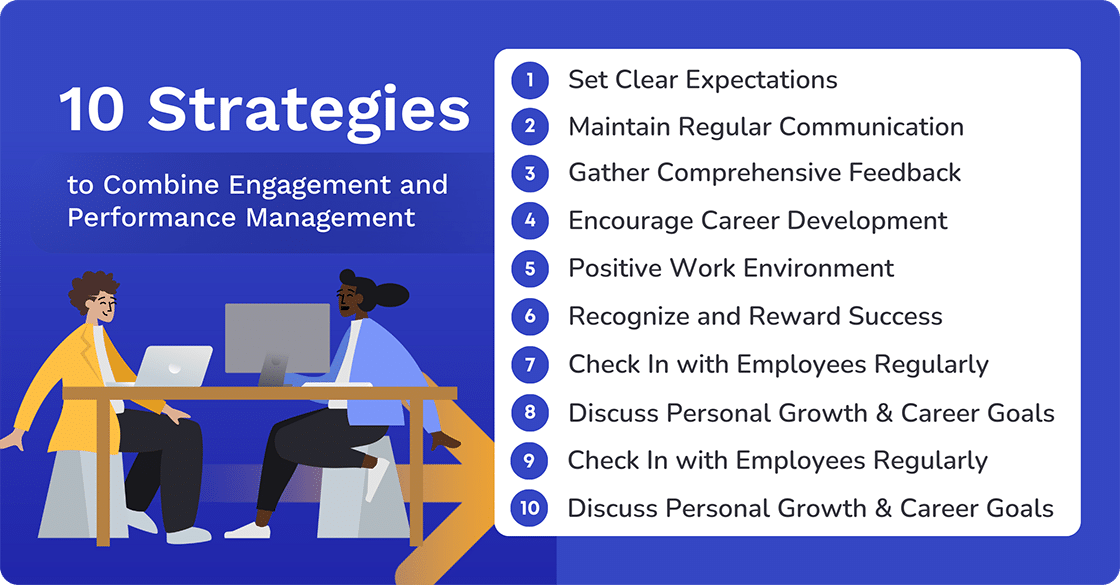Successful organizations know that employee engagement and performance go hand in hand. We tell you why integrating them is so important.

.png)
It can be difficult to know what to include in an employee survey. That’s why we have created a template that you can use for FREE to ensure your employee surveys are engaging. Get the responses that will help you understand your audience.
Access NowOrganizations are continually seeking ways to enhance productivity and achieve outstanding financial results. One of the key factors driving organizational success is the link between employee engagement and performance. Understanding this connection is vital for fostering a thriving workplace and achieving long-term goals.
Research results published by McKinsey & Company show that companies focusing on employee performance are 4.2 times more likely to outperform. Furthermore, they can realize average revenue growth that is 30% higher and experience attrition that is 5% lower.
A 2024 article, In the spotlight: Performance management that puts people first, written by three McKinsey partners from international offices, states that when companies focus on employees and their organizational health, they reap dividends. These impact positively on culture, collaboration, and innovation — as well as sustained competitive business performance.
The problem is that nowadays, company leaders tend to lack confidence in most performance management systems. Despite their importance and value, leaders cite issues like fragmentation, misalignment, and inconsistency as common challenges.
“Performance management systems help people continuously develop—but most companies fall short of best practices. A set of defined design choices can help guide leaders forward.”
McKinsey & Company
Craft effective surveys to measure employee sentiment and boost engagement
.png)
Employee engagement is the emotional commitment an employee has toward their organization and its goals. When they are engaged, employees are more likely to put in extra effort, show dedication, and be passionate about their work.

Gallup defines employee engagement as the involvement and enthusiasm of employees in their work and workplace. Their extensive research spanning decades consistently demonstrates that engaged employees outperform their disengaged counterparts in driving superior business results. This correlation holds true across diverse industries, company sizes, nationalities, and economic climates.
However, their research indicates that only 23% of employees globally and 33% in the U.S. are “engaged.” When they analyzed performance differences in the business environment, they found that the benefits of employee engagement were abundantly clear.
For instance, engaged companies experience 23% higher profitability and 18% higher productivity (in terms of sales). Additionally, engaged employees also improve customer satisfaction, loyalty, and retention by 10%.
On the other hand, employee disengagement can have severe repercussions on business performance and profitability. Disengaged employees are typically less productive, have higher absenteeism rates, and are more likely to leave the organization.
The Gallup 2024 State of the Global Workplace report estimates that low employee engagement costs the worldwide economy US$8.9 trillion, which is 9% of the global GDP. This shows why addressing disengagement is so crucial for maintaining a healthy bottom line.
Craft effective surveys to measure employee sentiment and boost engagement
.png)
Performance management is a strategic approach to enhancing team and individual employee performance, ultimately driving organizational success. This systematic process involves setting clear expectations, providing regular feedback, recognizing achievements, and fostering professional development. By aligning individual goals with organizational objectives, performance management empowers employees to contribute meaningfully while creating a culture of continuous improvement.

Despite their close relationship, employee engagement and performance management are often treated as separate entities. Performance management traditionally focuses on evaluating an employee's work and providing feedback, while employee engagement deals with the emotional and motivational aspects of those in the workforce. This can lead to missed opportunities to leverage employee engagement to boost performance.
According to Gartner’s Top 5 Priorities for HR Leaders in 2024, nearly half of employees view their current performance as unsustainable. Similarly, only about half trust their organization.
The integration of employee engagement and performance management is essential for driving organizational success. By aligning these two critical areas, organizations can create a high-performance culture where employees feel valued, motivated, and empowered to contribute their best work. When employees are engaged, they are more likely to be committed to organizational goals, take ownership of their roles, and actively seek opportunities for growth and development.
To bridge the gap between performance management and employee engagement, organizations must adopt a holistic approach that focuses on both individual and organizational performance. This involves setting clear expectations, providing regular feedback, recognizing achievements, and fostering a supportive work environment. By creating a culture where employees feel valued, heard, and challenged, organizations can unlock the full potential of their workforce and achieve sustained success.
Understanding the benefits of this integration is crucial for organizations looking to enhance various aspects of their operations such as. We have already mentioned some of them, but here is a concise rundown.
Enhanced productivity: Engaged employees are more committed to their work and demonstrate higher levels of efficiency. This synergy between employee engagement and performance management drives employees to perform at their best.
Lower turnover rates: Companies with strong employee engagement and performance management practices can retain top talent more effectively. This investment in employee engagement and development significantly reduces turnover rates.
Positive work culture: Combining engagement and employee performance management creates an environment where employees feel valued and motivated. This improved workplace culture enhances employee well-being and improves overall company performance.
Alignment with organizational goals: This integration ensures employees' efforts are aligned with organizational objectives that are essential for long-term success. Engaged employees understand the company's mission and know how to achieve it.
Innovation and creativity: Engaged employees are more likely to contribute innovative ideas and solutions. The integration of engagement and performance management encourages employees to take risks and think creatively, driving organizational growth.

Effectively integrating employee engagement with performance management is crucial for building a workforce that is both motivated and productive. McKinsey identifies four basic elements of performance management: goal setting, performance reviews, ongoing development, and rewards.
With these in mind, we have identified a wider range of strategies to seamlessly combine performance management with employee engagement.
Clearly defined roles, responsibilities, and performance expectations create a foundation for success. When employees understand their contributions to the organization's goals, they are more engaged and focused. Clear expectations reduce ambiguity, prevent misunderstandings, and foster a sense of ownership over one's work. By aligning individual goals with organizational objectives, companies can create a shared vision and drive performance excellence.
Frequent and open communication is the cornerstone of a thriving workplace. It fosters transparency, trust, and a sense of belonging. Regular team meetings, one-on-one check-ins, and open-door policies encourage two-way dialogue, enabling employees to share ideas, concerns, and feedback. Effective communication channels, whether in-person, virtual, or through collaboration tools, ensure information is disseminated promptly and accurately.
Collecting feedback from multiple perspectives offers a holistic view of an employee's performance. By incorporating input from peers, supervisors, subordinates, and even customers, organizations can identify strengths, weaknesses, and development areas. This comprehensive approach promotes self-awareness, facilitates growth, and enhances overall performance. When employees receive constructive feedback from various sources, they gain a deeper understanding of their impact on the team and the organization.
Investing in employee growth is a strategic imperative. By offering opportunities for professional development, organizations demonstrate their commitment to employee success. Creating personalized career paths, providing mentorship and coaching, and offering tuition reimbursement programs are tangible ways to support employees' aspirations. Regular performance reviews should include discussions about career goals and development plans.
A positive work environment is characterized by mutual respect, collaboration, and a shared sense of purpose. It's essential to cultivate a culture where employees feel valued, heard, and appreciated. This involves fostering open communication, recognizing and celebrating diversity, and promoting work-life balance. By creating a psychologically safe space where employees can be themselves and take risks, organizations can unleash creativity, innovation, and productivity. Additionally, addressing issues such as bullying, harassment, and discrimination is crucial for maintaining a positive and inclusive workplace.
Recognition and rewards are essential for motivating employees and reinforcing desired behaviors. Publicly acknowledging achievements, providing timely feedback, and offering tangible rewards can significantly boost morale and engagement. It's important to tailor recognition programs to different employee preferences and to ensure that rewards align with organizational values. By celebrating successes and showing appreciation for employees' contributions, organizations can create a culture of high performance and achievement.
Regular check-ins provide an opportunity for managers to connect with their employees, build trust, and address any concerns or challenges. These conversations should focus on both work-related and personal well-being. By actively listening to employees' feedback, managers can identify potential issues early on and take corrective action. Regular check-ins also help employees feel supported and valued, which can lead to increased employee engagement and job satisfaction.
To foster long-term employee engagement, organizations must invest in their employees' personal and professional growth. Regular conversations about career aspirations, skills development, and individual goals demonstrate a genuine interest in employees' futures. By aligning individual goals with organizational objectives, employees feel more connected to the company's mission and are more likely to be motivated to succeed. Creating opportunities for employees to take on new challenges and responsibilities can also help them develop new skills and advance their careers.
Continuous learning is essential for staying competitive in today's rapidly changing business environment. By providing access to training and development opportunities, organizations can empower employees to acquire new skills and knowledge. Offering tuition reimbursement, affordable online courses, and professional development workshops can demonstrate a commitment to employee growth.
Focusing on employees' strengths is a powerful way to enhance performance and engagement. By identifying and leveraging employees' talents, organizations can create high-performing teams and foster a positive work environment. Providing opportunities for employees to use their strengths can increase job satisfaction, motivation, and overall well-being.

Cerkl Broadcast is designed to help you achieve employee engagement, loyalty, and retention. The platform’s omnichannel capabilities streamline comms by ensuring your employee audience receives and read communications in the channels they prefer to use.
We’ve talked briefly about the challenges organizations with remote employees face. Broadcast is particularly effective when it comes to engaging deskless workers. It also enables personalized comms in mass. Reach pre-defined employee segments in a single click.
Of course, when employees are properly informed, they will also perform better and ultimately be more productive. Broadcast improves collaboration by breaking down silos and keeping everyone aligned. Because it enables you to gather feedback in real-time, it increases engagement and helps to build trust.
Employee engagement is a vital element of a successful business strategy. Do you know how well your employee engagement strategy is working? Maybe not. No worries. We have created an employee survey template to help you measure employee engagement in your organization. And we’re offering you access absolutely free.
.png)
Craft effective surveys to measure employee sentiment and boost engagement
What is employee engagement and performance? Employee engagement is the level of commitment and passion employees demonstrate towards their work and organization.
How does employee engagement affect productivity?
Employee engagement directly impacts productivity by influencing factors like motivation, job satisfaction, and employee turnover.
How much better do engaged employees perform? Engaged employees typically outperform their disengaged counterparts by a significant margin, leading to increased productivity, innovation, and customer satisfaction.

Craft effective surveys to measure employee sentiment and boost engagement